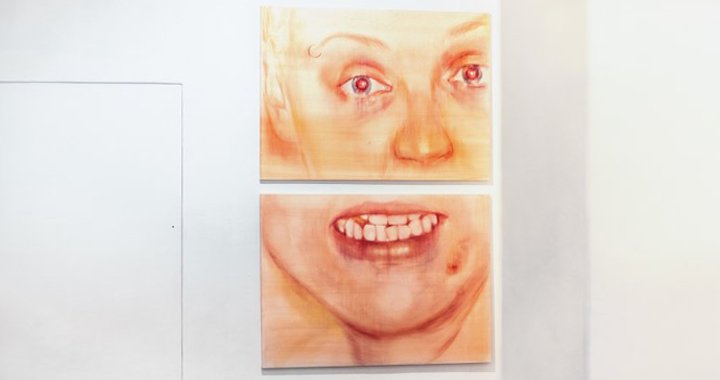
Baltic exhibition guide
November
12/11/2019
TALLINN
Do Come in, the Door is Open!
KUMU exhibition spaces
11 October till 29 March

From 11 October till 29 March, a joint exhibition by Edith Karlson, Mary Reid Kelley and Eva Mustonen is on view at KUMU exhibition spaces.
The title of the exhibition is a quote taken from the legendary Estonian TV series Õnne 13 (directly translated as “13 Happiness Street”): the phrase is how the shoemaker Johannes, a classically jovial and wise old man, used to greet any guest knocking on his door. This essentially friendly utterance expresses openness and hospitality even before the host has seen the newly arrived acquaintance or stranger. Today, years after the TV series became a classic, such trust in the unknown seems unexpectedly relevant, almost like a political statement, and is therefore worth recalling. But, within the context of this exhibition, it is also an absurd invitation: you are asked, without any guarantee whatsoever, to enter a distorted-mirror environment which is rooted in things mundane or personal and aims to take a more general stand on contemporary neuroses and tensions.
The exhibition consists of works by three artists who, despite working in different media and completely dissimilar aesthetics, speak somewhat similar languages. The art practices of Edith Karlson, Eva Mustonen and Mary Reid Kelley can, in the broadest of terms, be characterised as narrative art that uses fiction as a method. In their works, this takes the form of allegorical, autobiographical or mythological narratives, and is also manifested through the creation of strong characters (people as well as objects) and mostly dramatic events. In other words, all three artists are essentially type-wise storytellers who use both words and visual images, often combining the two, to tell their stories.
The exhibition is curated by Triin Tulgiste.
An overview by Vello Vinn
Art Hall Gallery
17 October till 15 December
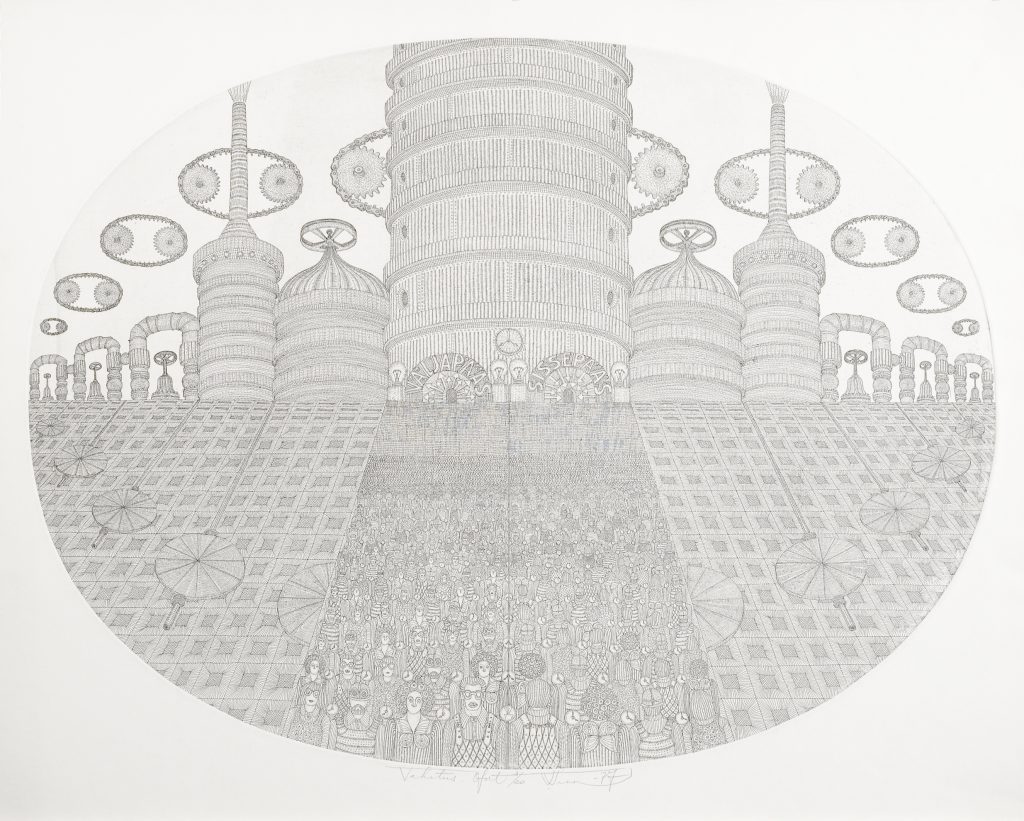
An overview exhibition of the graphic art of Vello Vinn titled “∞ & ○” (infinity and circle) gives an outline of the artist’s more than half-century-long career. The thematic core of the exhibition is the developmental trajectory of one of the most innovative post-war Estonian graphic artists, starting from the 1960s up to this day. This also explains the cryptic, symbol-based title of the exhibition which, naturally, hints at the systematic symmetry principle governing much of Vello Vinn’s oeuvre.
Vello Vinn’s work has been exhibited at several international triennials and biennials (the 9th Ljubljana Biennial of Graphic Arts, Prix d’Emona 1971; the 36th International Venice Art Biennale’s satellite exhibition “Graphic Art of Today” in 1972), as well as other solo and group exhibitions. His artworks belong to several important museum collections, including: the Art Museum of Estonia in Tallinn, the State Tretyakov Gallery in Moscow, the Ludwig-Forum für Internationale Kunst in Aachen, and the Norton and Nancy Dodge collection at the Zimmerli Art Museum, among others. He has been a member of the Estonian Artists’ Association since 1970 and an honorary member since 2013.
The exhibition is curated by Andreas Trossek.
A-tishoo, A-tishoo, We All Fall Down
EKKM
2 November till 15 December

The group exhibition “A-tishoo, A-tishoo, We All Fall Down” at the Contemporary Art Museum of Estonian is on view until 15 December.
For the first time, the Estonian Centre for Contemporary Art (CCA) is curating collectively in order to bring together different experiences and ways of thinking as well as to save resources and reduce overproduction. The exhibition includes the artists Ivana Bašić, Pakui Hardware, Anu Juurak, Jussi Kivi, Raul Keller, Johanna Maria Parv, Hanna Samoson, Emilija Škarnulytė, Peeter Ulas, Brit Pavelson and Sissela Jensen, and Aaloe-Ader-Flo-Künnap-Soosalu. Events accompanying the exhibition have been created by Mare Tralla and the Üle Prahi group.
The exhibition deals with dread and hopelessness. It reflects a self-destructive situation where the man-made world is turning on us in an increasingly forceful way. With the participating artists of the exhibition, a journey is created – one that is guided by uncertainty about what lies ahead.
The show is curated by Marika Agu, Maria Arusoo, Kaarin Kivirähk and Sten Ojavee.
EVENT Body Space(d)
Tallinn Art Hall
27 till 30 November
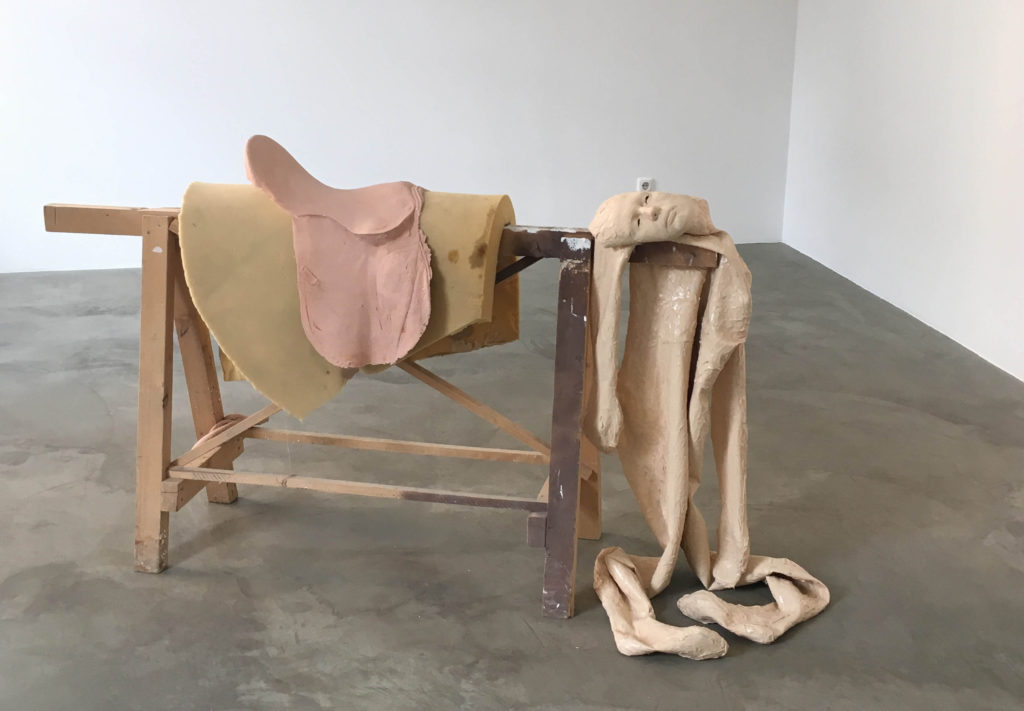
Between 27 and 30 November, Tallinn Art Hall and Sõltumatu Tantsu Lava will present the joint project “Body Space(d)”, which brings together three pairs of artists from the Estonian visual arts and performance scenes. Each pair will collaborate on a unique, one-night-only performance. Curator Evelyn Raudsepp has invited three artist duos to create performative works: Edith Karlson and Sigrid Savi, Rene Köster and Mark Raidpere, and Flo Kasearu and Renate Keerd. On three consecutive nights, the results of these collaborations will be presented and then concluded on the fourth night with a diverse programme featuring discussion, music, and the creation of shared space.
At Tallinn Art Hall, research into the two symbolic spaces / two fields of art continues – i.e. the white cube and the black box – but this time the body is also placed into the mix. The combination of the invited artists’ practices and the thematic framing allows experimentation to take place within the clinical white cube with theatrical means. It also enables the artists to look into connections between embodied performance and the richness of artistic expression in visual art. Sculptor Edith Karlson and performing artist Sigrid Savi have found common ground in the galloping of the Wild West and the glide of pole dancing. Choreographer and drag queen Rene Köster and photo and video artist Mark Raidpere use the camera to bring forth the expressiveness of identities. Artist Flo Kasearu and theatre director Renate Keerd both refreshingly use the absurd in their work, as well as rely on a symbiosis of media and puckish playfulness.
RIGA
Evita Goze. On Guard
ISSP Gallery
18 October till 27 November

Organised by the Ministry of Defense of the Republic of Latvia, the Youth Guard is a voluntary movement for children and young people aged 10 to 21 years. It can be looked at as a contemporary ritual of initiation into adulthood, which at the same time satisfies the romantic boyhood dream of going back to nature. The exhibition “On Guard” is a partly anthropological, partly staged five-year-long observation of the Youth Guard. Choosing adolescents who are in the process of learning how to be men and soldiers as the subjects of her work, Goze emphasises vulnerability, insecurities, inconsistencies, and moments of rest or suspension. By doing so, she stresses the performative and unstable nature of masculinity and the soldier figure itself.
Evita Goze is a curator, writer and photographer based in Riga, Latvia. She received her BA in Photography from the University of Brighton, UK, and her MA in Visual Communication from the Art Academy of Latvia. Her primary medium of expression is photography, but she also uses text, vernacular photography and found objects in her work. Her work has been shown in Latvia, Lithuania, Austria, Canada, Germany, India, Japan, the Netherlands and the UK, and has been published in the Latvian Photography Yearbook, The Guardian, YET magazine, The Calvert Journal and elsewhere. “On Guard” is her first solo exhibition in Riga.
The exhibition is curated by Iveta Gabaliņa.
Maija Nora Tabaka. Anniversary exhibition
Gallery Daugava
31 October till 7 December
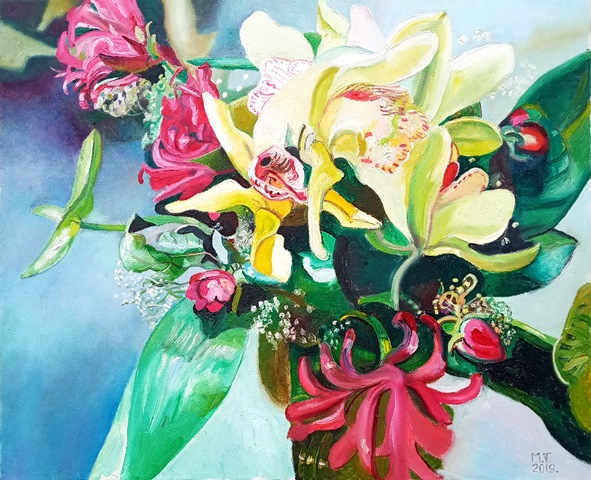
In November, the painter Maija Nora Tabaka will celebrate a very significant birthday. Very few people can claim that painting is their whole life, yet Tabak can – and no one even slightly familiar with her art will doubt it. Maija Tabaka’s painting is exuberant, at times even dazzling because of her unlimited imagination. It is fascinating to follow, though sometimes indeed impossible; we only need to trust and believe her. In her canvases, day and night merge while centuries, locations and latitudes change. Her paintings radiate a wide range of emotions: sadness, heartache, joy and love. They are beautiful, and it is no wonder as Maija Tabaka herself has admitted that she paints only what she likes. Last summer she painted flowers, each uniquely structured because flowers are a world of colours and absolute beauty. Many artists are reluctant to paint flowers, though according to the common saying, it doesn’t matter what you paint but how you paint. For Maija Tabaka, what and how to paint have always been equally important. Along with the floral paintings, viewers will see several artworks from the past which have rarely been seen by the public.
Tobias Kaspar’s “The Estate / Autumn”
Kim? Contemporary Art Center
1 November till 15 December
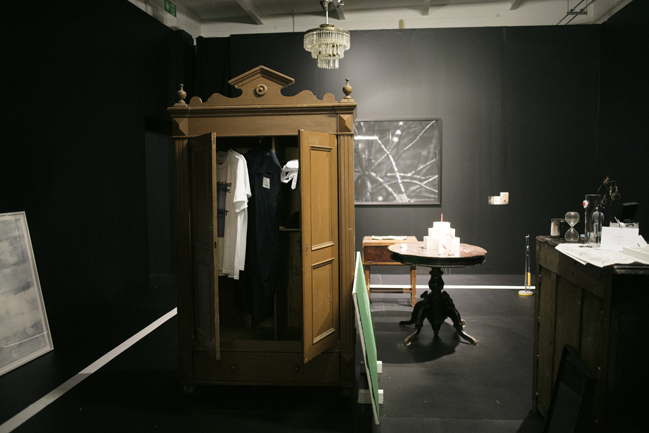
What if an art collector – or in more modest terms, a person interested in art who, from time to time, also happens to purchase, exchange, and receive artworks as gifts – spent their summers in rural Latvia? What would that house – or let’s just go grand: what would that estate look like? Of what would it be reminiscent? Would the house pay homage to the shabby chic of Anna Karenina, or the Eurodesign that dominated 1990s interiors? Would it lean towards the Soviet-esque, or would it stick to the pre-war, Baltic-German style?
The exhibition space turns into an architectural maze without walls, turning its focus on de-acquisition. The collection contains furniture from the summer house and new works realized on site during the SUMMER edition exhibition – here they have been placed inside of a dystopic installation, endowing the collection with a slightly grotesque background. Looking at the displayed artworks, it becomes clear that the collection or taste of our “collector” is far from what one would call “blue chip”, that is, a collection in which “signature style” and key works” prevail; instead, it contains many by-products and leftovers. Smaller, earlier works provide an image of a rather dirty but engaged collection, one in which the artworks form part of what could be described as a “conversation piece”, to quote both the eponymous 18th-century English portraiture style and the 1974 Luchino Visconti film.
Included are works by: Eriks Apalais, Tristan Bera, Gerry Bibby, Drew Kahu’āina Broderick, Stefan Burger, Merlin Carpenter, Nicolas Ceccaldi, Vija Celmins, Jay Chung & Q Takeki Maeda, David Douard, Ramon Feller, Ffixxed Studios, Gina Folly, Oleg Frolov, Ryan Gander, Liam Gillick, Edgars Gluhovs, Dominique Gonzalez-Foerster, Guerilla Girls, Karl Holmqvist, Daniel Horn, Morag Keil, Emil Michael Klein, Fred Lonidier, Miltos Manetas, MAY, Daria Melnikova, Daniele Milvio, Jonathan Monk, Sveta Mordvskaya, Carter Mule, Kärt Ojavee, Josephine Pryde, Cinzia Ruggeri, Hinrich Sachs, Cindy Shermann, Mike E. Smith, Sarah Staton, Rikrit Tiravanija, Lucas Uhlmann, Miriam Visaczki, Danh Vo, Marie-Pascale Wellinger, Pedro Wirz, Seyoung Yoon, Artur Zmijewski.
The exhibition is curated by Zane Onckule.
VILNIUS
Two exhibitions at Vartai Gallery
24 October till 29 November

From 24 October till 29 November, Vartai Gallery is showing two exhibitions – the solo show “OMENY” by Aidas Bareikis, and “Translation Error” / “Vaizdinis vertimas” by Donata Minderytė.
A painter of the young generation, Donata Minderytė’s show features a series of recent works created during 2019. While consistently developing themes she explored in the earlier stages of her creative work, Minderytė reflects on the relations between lived experiences, their memories, and the media used to express them – at first in photography, and then later, in painting. By invoking the concept of visual translation, Minderytė analyses the semantic shifts of an image and the fluctuations in their meaning. In rethinking the function of an image in painting, the artist looks for new details of significance. As she herself puts it: “Not everything is as it appears, and not everything appears as it is.” Minderytė often employs video stills and photographs for her painting work. However, she focuses on what appears antithetical to high quality photography—she chooses images which, instead of accurately representing moments that have passed, bring out the falsities in photography as a medium; she does this because, not unlike a bad translation that alters meaning, these captured images distort, contradict and mismatch the memories they are supposed to represent. In her paintings, Minderytė captures fading, broken fragments of a past time that have been removed from their original state – the fragments have changed due to the flow of time and through what at first glance appear to be the objective media of video and photography. She focuses specifically on the blurring of the original meaning and the change in the message of the captured image, while expressing the fluctuations of a memory in her paintings by means of modifications in a moment of paused time.
Aidas Bareikis is one of today’s most prominent Lithuanian emigrant artists; his work is characterised by a critique of social, cultural and political environments. His urban installations created employing the ready-made principle and paintings with a basis in automatism are constructed as chaotic structures evocative of entropy. He plants his objects – both bought and found – as if they were potatoes growing on a roof and harvested in spring. Not unlike some Anthropocene alchemist, Bareikis explores the life of objects and our psychological relationship to them. According to the artist, every object is a potential piece of rubbish, and the factors that determine how fast an object is turned into rubbish do not depend on its physical qualities. The possession of an object implies a relationship with it that is more complicated than its representation.
In his new show, Bareikis draws on the roots of cubism and investigates ways of reflecting on the fluidity of consciousness through its own continuity. While in the first half of the 20th century this was done by transferring physical solid objects and their strict geometrical forms into a painting – a two-dimensional plane – “OMENY” does the opposite: here, painting emerges as a sign of an ever-continuing consciousness in spatial, three-dimensional geometrical forms. Sculpture become painterly, and the abstract is no longer completely abstract but retains a holistic view – even though the objects that comprise an artwork are still individually recognisable, their essence is revealed only through a new form of the whole.
Monika Furmana. Mechanical Soul
TSEKH Gallery
26 October till 22 November
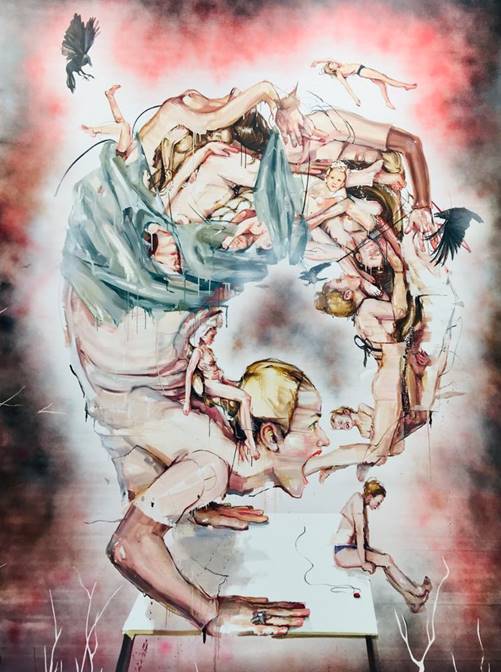
To mark the celebration of its 17th birthday, the Vilnius-based Meno Niša Gallery invites everybody to visit Monika Furmana’s exhibition of paintings titled Mechanical Soul, featuring works of an impressively monumental size – up to 5 metres in height. As Meno Niša’s spaces are not spacious enough to display such large paintings, the Mechanical Soul exhibition is being hosted by Tsekh Gallery.
With this exhibition, Monika Furmana seeks to reveal the human as an integral part of the material environment. The main theme in Monika Furmana’s works is a woman and her body. In her artworks, the artist provocatively and intrepidly deconstructs a woman’s body and changes her identity. The artist is fascinated by the blurring of boundaries and contrasts that are both shocking and exciting at the same time, explaining: “The being of everyday objects is saturated with meanings both acquired and imposed. Through painting, I attempt to deconstruct these meanings to get down to the very nucleus of a thing, leaving a substance that is, as much as possible, unplanned, naked, and more real.”
The Study. Genesis of Artwork.
National Gallery of Art
15 November till 26 January

From 15 November till 26 January, the exhibition “The Study. Genesis of Artwork” by Augustinas Savickas will be on view at the National Gallery of Art.
There are three main participants in this exhibition: the author (the artist), his workspace (the workshop or study), and the artwork.
The first participant does not really need to be introduced – Savickas is a bright figure in Lithuanian art history: painter, art historian, educator, writer. A multicoloured personality who created art in the second half of the last century and at the beginning of this millennium. For many years he lived productively, constantly changing and transforming; the artist both represented his own epoch and influenced it.
Savickas' workshop, which often changed locations and presentations, not only mirrored the social status of this artistic and cultural figure in Soviet and post-Soviet society, but also encompassed a physical and material representation of Savickas’ aspirations, desires, aims, expectations and even failures – the entirety of his passionate temperament. While there, it was possible to see, feel and understand where Savickas was coming from, who he was, and where he was going (to rephrase Paul Gauguin). His workspace was not just defined by four walls but also by a window to the city, to nature, and to his beloved wife Liza's cherished garden; and by the surroundings of people, books both flipped-through and read, and other cultural artifacts and memories.
The fundamental purpose of the artist's studio was the creation of art. Physical work met with scientific research and poetic inspiration. As a creation in itself, the study served as a shelter (or even a womb) where works were born, formed and finally brought into the world as artworks. These artworks can be categorised into stages or periods, as well as classified into thematic or conceptual groups – this has been done with the collection of works in the exposition. Sometimes it occurs naturally, as though paintings floated together like clouds in the sky of creativity – in the study.
The aim of this exhibition is to recreate Savickas' study. Yet this restoration is only of a symbolic nature. In this sense, the exhibition is reminiscent of the Garden of Eden (or maybe more so the garden created by his beloved wife, Liza), or even Čiurlionis-esque (researched and appreciated by the art historian and artist alike). The universe promenades through it, recalling Savickas' restless creative journey with his own heritage and downfalls; with the creation of paintings from sketch to the final piece; with the pursuit of motifs and images stuck in the subconscious.
The exhibition is curated by Vidas Poškus.
www.ndg.lt